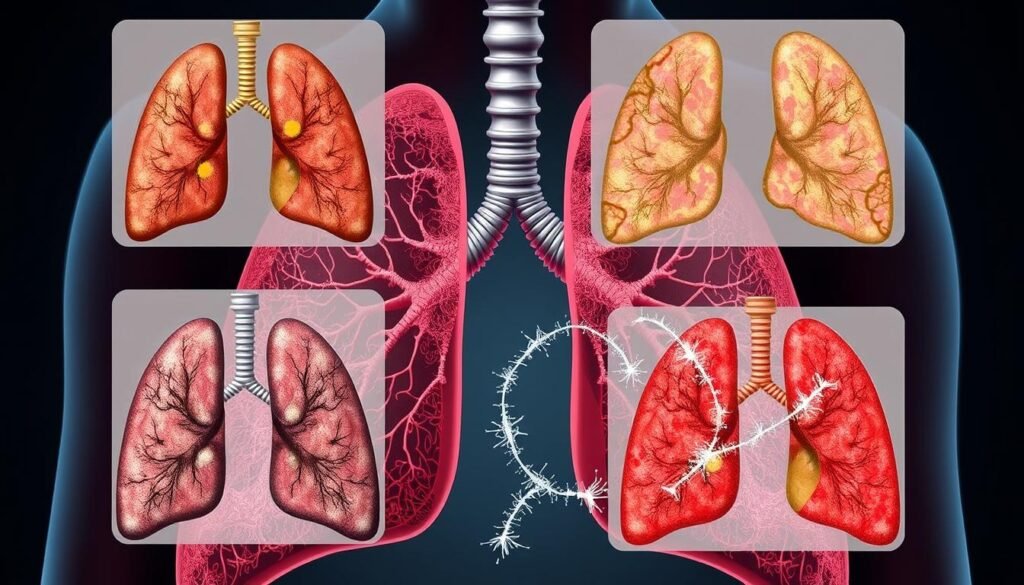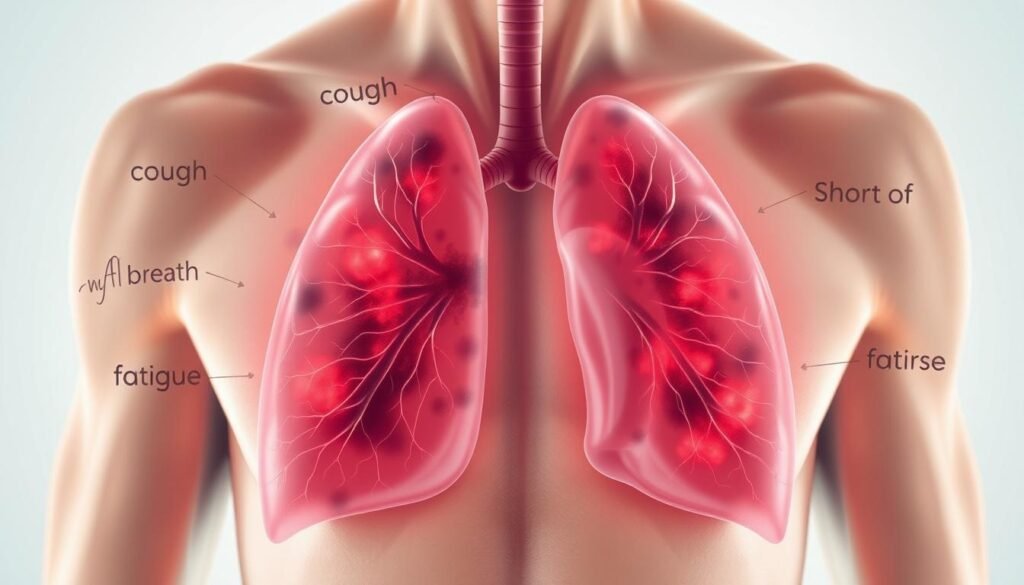It’s alarming that asbestos has been linked to lung cancer since the 1930s. Recent studies show that asbestos-related lung cancer is a bigger problem than mesothelioma. Each year, about 6,000 deaths in the U.S. are because of this.
This guide dives into the dangers of asbestos and smoking, both key causes of lung cancer. We’ll look at how they work together, the kinds of lung cancers they cause, and what this means for preventing cancer. You’ll understand the risks of asbestos and smoking lung cancer. Plus, you’ll see why it’s vital to stay informed and take steps for your health.
Key Takeaways
- Asbestos exposure is a significant factor in lung cancer cases.
- Smoking combined with asbestos exposure amplifies cancer risks.
- Lung cancer from asbestos exposure takes 15 to 35 years to develop.
- Regular monitoring and preventive measures are crucial for at-risk individuals.
- Asbestos causes a substantial proportion of occupational lung cancer cases.
Understanding Asbestos Exposure
Asbestos exposure is a big concern for public health. It is linked to many serious diseases. This mineral fiber is found naturally and was once prized for making buildings and products because of its ability to resist heat and wear.
However, its durability and heat resistance have a dark side. They lead to health problems like breathing issues and lung cancer. The International Agency for Research on Cancer has marked asbestos as a known cause of cancer. This shows how dangerous breathing in these fibers can be.
In the U.S., the use of asbestos has greatly reduced. It went from about 803,000 metric tons in 1973 to around 360 metric tons by 2015. This drop shows that more people understand how risky it is, especially for workers in certain jobs.
Many American workers have been exposed to asbestos since the 1940s. High-risk industries include shipbuilding and automotive manufacturing. There’s no safe level of exposure to asbestos. Studies show this, especially for auto mechanics working on brakes.
The risk isn’t just at work. People caught in the 9/11 attacks also faced more exposure due to the destruction. The impact takes 10 to 40 years to show, making it hard to diagnose and treat. Not only workers but their families can get sick from it too.
People living near asbestos mines also face risks. This shows the need to know the dangers of asbestos where you live. What makes you sick from asbestos depends on how much you’re exposed, for how long, and the type of fibers.
Your own health and genetic factors also play a role. For asbestos workers who smoke, the risk of deadly lung problems goes up even more. As more people fight for stricter rules, understanding and avoiding asbestos becomes even more important. This knowledge is key to preventing diseases and keeping people safe.
| Asbestos Exposure Factors | Description |
|---|---|
| Exposure Dose | The amount of asbestos inhaled, directly impacting the risk level. |
| Duration of Exposure | Longer exposure times increase the likelihood of developing diseases. |
| Type of Asbestos Fibers | Certain types of fibers pose a higher risk for various health issues. |
| Genetic Factors | Specific genetic mutations may predispose individuals to asbestos-related diseases. |
| Smoking | Significantly increases the risk of lung cancer and other respiratory illnesses among exposed individuals. |
Link Between Asbestos and Lung Cancer
The link between asbestos and lung cancer is a key focus in medical studies. Many studies show a clear connection between exposure to asbestos and getting lung cancer. It results in thousands of deaths in the U.S. each year.
Research shows a direct relationship between asbestos exposure and lung cancer risk. A study with over 8,000 workers in Denmark found a higher risk of adenocarcinoma. Also, workers exposed to asbestos and tobacco smoke had a much higher lung cancer risk.
Animal studies confirm that all types of asbestos can cause tumors. An analysis showed a high percentage of men with asbestos exposure and smoking developed lung cancer. Several factors can increase the risk of getting this cancer.
This evidence shows a strong and harmful connection between asbestos and lung cancer. Understanding this can help spot early signs, like coughing up blood or sudden weight loss. We need more awareness and prevention against asbestos exposure.
Asbestos and Smoking Lung Cancer Risk
When asbestos and smoking mix, the danger of lung cancer grows significantly. Together, they increase the risk more than they do on their own. We will look into how smoking and asbestos together have a synergistic effect. We’ll also discuss the cumulative risk factors that make this issue a severe health concern.
Synergistic Effects of Combined Exposure
Being around asbestos already ups your lung cancer risk. If you smoke too, the risk goes up by five times. This happens because smoking affects how your lungs work. It makes it harder for them to get rid of asbestos fibers. This, along with asbestos’s own cancer risks, significantly raises lung cancer cases. To understand why this mix is so dangerous, check out the biological mechanisms.
Cumulative Risk Factors
Risk factors stack up; it’s not just about how much asbestos you’re around. Smokers, even those who’ve stopped recently, are still at more risk. If you quit less than seven years ago, your risk is 22 times higher than if you never smoked. Most lung cancers are linked to smoking. This is true even if you’re only around a little asbestos. This shows how smoking and asbestos together can lead to lung scarring and cancer. It’s vital for people to know this, especially if they’re at risk.
| Exposure Type | Relative Risk of Lung Cancer |
|---|---|
| Non-Smoker with Asbestos Exposure | Higher than average risk |
| Smoker without Asbestos Exposure | 85% – 90% of lung cancer cases |
| Smoker with Asbestos Exposure | 5 times higher risk |
| Quitting Smoking within 7 years and Asbestos Exposure | 22 times higher risk |
Types of Lung Cancer Linked to Asbestos
Asbestos exposure plays a big role in different lung cancers, especially Non-Small Cell Lung Cancer (NSCLC) and Small Cell Lung Cancer (SCLC). Knowing about these types helps us see risk factors and treatment choices.
Non-Small Cell Lung Cancer (NSCLC)
Non-Small Cell Lung Cancer (NSCLC) makes up about 80-85% of lung cancer cases. It includes adenocarcinoma, squamous cell carcinoma, and large cell carcinoma among others. Compared to SCLC, NSCLC grows more slowly. It often happens in people who were around asbestos. How well someone with NSCLC does depends on when they find out they have it and their health.
Small Cell Lung Cancer (SCLC)
Small Cell Lung Cancer (SCLC) is about 10-15% of lung cancer cases. It grows quickly and is closely linked to smoking. Most people with SCLC used to smoke. But, asbestos makes SCLC even more dangerous. Symptoms usually don’t show up until later, making it hard to find and treat early.
Asbestos’s link to lung cancer shows why regular checks are key for those at risk. For more on how asbestos relates to lung cancer, visit this resource.

Significance of Occupational Hazards
Understanding occupational hazards is crucial, especially when it comes to asbestos exposure. Many jobs carry a high risk, showing how exposure to dangerous materials affects health. Workers in fields like construction, manufacturing, and the military often come into contact with asbestos. This raises their chances of getting serious illnesses, such as lung cancer.
High-Risk Professions and Asbestos Exposure
Nearly 3% of lung cancer cases in Canadian men are linked to workplace asbestos exposure. A notable study found 1,681 incident cases of lung cancer, with 2,053 controls, between 1994 and 1997 in eight Canadian provinces. If men were exposed to medium or high levels of asbestos, they were twice as likely to develop lung cancer compared to those not exposed. The main places for asbestos contact in Canada are during the repair, renovation, and demolition of pre-1980 buildings.
Impact on Veterans and Workers
Veterans, especially those who worked in shipbuilding or construction, are at higher risk because of asbestos. In 2012, 10,800 lung cancer deaths were estimated to happen. Around the world, 125 million people are still exposed to asbestos at work, showing the challenge remains. These figures make it clear that jobs involving asbestos greatly increase disease risks. This points out how important it is to have better safety and health support.
| Study Parameter | Value |
|---|---|
| Incident Cases of Lung Cancer | 1,681 |
| Controls Recruited | 2,053 |
| Odds Ratio for Lung Cancer (Medium/High Exposure) | 2.16 (95% CI=1.21-3.88) |
| Estimated Lung Cancer Diagnoses (2012) in Canada | 13,300 |
| Estimated Lung Cancer Deaths (2012) in Canada | 10,800 |
| Global Workers Exposed to Asbestos | 125 million |
Secondhand Smoke Exposure in Relation to Asbestos
Being near smokers can up your risk for lung cancer, almost like smoking yourself. Data shows that secondhand smoke ups lung cancer risk by 24%. It’s a big health issue that needs attention.
Secondhand smoke and asbestos together make lung cancer even more likely. The more you’re around smoke, the higher the risk. For example, the risk is higher at work than at home.

Asbestos adds to the danger, especially in people with asbestosis. They have a 13.2% lung cancer rate, way higher than those with silicosis at 1.3%. Smoke and asbestos together are a bad mix, making lung cancer risks shoot up.
It’s important for public health to tackle smoke and asbestos exposure together. Cutting tobacco use and managing environmental risks can help lower lung cancer in everyone. Check out the link for more on secondhand smoke and lung cancer. Awareness and prevention are key.
| Setting | Relative Risk (95% CI) |
|---|---|
| Home | 1.20 (1.12–1.28) |
| Workplace | 1.38 (1.28–1.62) |
| Home or Workplace | 1.37 (1.22–1.53) |
| Non-Specified Settings | 1.27 (1.11–1.44) |
Preventive Measures Against Lung Cancer
Stopping lung cancer starts with preventing it in the first place. Quitting smoking is the best way to do this. It greatly lowers your chance of getting lung cancer and helps your lungs heal over time. There are many programs to help smokers quit. They offer counseling, medication, and support groups to help beat addiction and stay healthy.
Importance of Smoking Cessation
About 90% of lung cancer in men and 80% in women comes from smoking. Smokers are 20 times more likely to get lung cancer than non-smokers. But quitting can drastically cut your risk. Ten years after quitting, your lung cancer risk drops by 30% to 60%. Stopping smoking helps you and everyone around you by reducing harmful secondhand smoke. This type of smoke causes thousands of lung cancer cases in non-smokers every year.
Asbestos Abatement Practices
Dealing with asbestos properly is key to reducing lung cancer risk from exposure. Asbestos abatement means safely removing or sealing off asbestos. This protects people in buildings from dangerous exposure. There are laws to keep workplaces safe by controlling asbestos use. These measures can help lower lung cancer risk, especially for those exposed a lot at work.
| Preventive Measures | Benefits |
|---|---|
| Smoking Cessation Programs | Reduces lung cancer risk significantly |
| Asbestos Abatement | Limits exposure to carcinogenic materials |
| Radon Testing | Protects homes from potential radon exposure |
| Avoiding Secondhand Smoke | Decreases lung cancer cases in non-smokers |
| Regular Health Screenings | Early detection of lung issues and cancer |
Recognizing Symptoms of Lung Cancer
Knowing how to spot recognizing symptoms of lung cancer is key. Often, people mistake them for less serious issues. Persistent coughing, shortness of breath, and losing weight without trying are common signs. These symptoms can look like those of other illnesses, which makes early detection hard.
Common Indicators and Risk Factors
Look out for these symptoms:
- Persistent cough that doesn’t go away after several weeks
- Chest pain that gets worse when you breathe deeply or cough
- Shortness of breath, especially when you’re active
- Getting lung infections like pneumonia often
- Hoarseness or a change in voice
- Unexplained weight loss
Knowing the risk factors for lung cancer is also crucial. Smoking is a big one, linked to 85-90% of cases. Being around asbestos increases risk too. Family history of lung cancer, exposure to radon gas, and contact with harmful substances like arsenic or chromium are important to note.
Importance of Early Detection
Early detection can make a big difference in treating lung cancer. Screenings are very important, especially for those at higher risk. They can help find the disease early, when it’s easier to treat. Going for regular health checks that include lung tests can catch problems soon. This means better chances of successful treatment. Paying attention to symptoms and risks can lead to taking action early, which might save lives.

Treatment Options for Asbestos-Related Lung Cancer
Treatment for asbestos-related lung cancer often combines many therapies. Each treatment plan considers the patient’s health and cancer stage. This makes each plan unique.
Multimodal Approaches in Treatment
Patients might get surgery, chemotherapy, and radiation. Being around asbestos can hurt your lungs over time. Combining treatments helps patients the most.
People with advanced disease might need extra oxygen. Or they could join a lung rehab program. Quitting smoking is also key to fighting this disease.
Innovative Therapies and Clinical Trials
Clinical trials are testing new ways to fight asbestos-related lung cancer. They’re looking at immunotherapies. These use your immune system to attack cancer. Some advanced treatments are being studied to help patients live longer, better lives.
| Treatment Type | Description | Benefit |
|---|---|---|
| Surgery | Removal of cancerous tissue | Can potentially eliminate cancer at an early stage |
| Chemotherapy | Use of drugs to kill cancer cells | Can reduce tumor size and spread |
| Radiation Therapy | Targeted radiation kills cancer cells | May relieve symptoms and improve quality of life |
| Immunotherapy | Stimulates the immune system | Targets cancer more effectively with less damage to healthy cells |
| Pulmonary Rehabilitation | Exercise training and education | Improves lung function and quality of life |
Patients with severe lung issues must have regular imaging tests. This helps doctors manage the disease better. Timely checks are crucial.
Conclusion
The link between asbestos and lung cancer risk from smoking is a key public health issue. Research since the 1930s shows a clear connection between being exposed to asbestos and getting lung cancer. People exposed to this dangerous substance have a far higher chance of getting this deadly disease. When someone is exposed to both asbestos and smokes, their risk of cancer goes up even more. This tells us how crucial it is to have strong cancer prevention methods.
It’s very important for people to know about the risks of asbestos and smoking, especially those in high-risk jobs. Studies show that smoking makes asbestos’s bad effects even worse. People exposed to both have a lung cancer death rate 28 times above the norm. So, teaching about these dangers is key. We need to encourage making better health choices and support community efforts. There’s also a push for better rules on clean air.
In summary, it’s crucial to get how asbestos and smoking together impact health. Quick medical help and smart cancer prevention plans can really lower lung cancer risks. As more people learn about these risks, they can fight for safer places. Making choices that keep us healthy in the long run is essential.